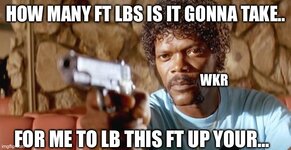While I suspect I may be getting myself in touble here...
Forums are for posting respectful opinions. If I may - here’s mine. Hope I'm in the right section??
Maybe I have these opinions because I’m older than you and the odds are high I am. Been around a long time. While many have indeed killed more game than I have – I’ve taken my share. The common theme during my range / hunt preparation and all my time afield? Cartridge ballistics. The right cartridge, the right bullet at relatively high speeds. Accuracy – tight groups – always a high priority. The time and work invested in those efforts always paid off at the trigger pull. 95% DRT. A fair estimate.
Cartridges? Way too many to list – all the oldies but goodies and a few new ones – from .222 up to and including .458 Win.
As time passed and rifles came and went, I learned a few things. Like you folks are now. Understandably, things change and Rightfully so. Some things though – don’t.
Over the years, I always chose a cartridge slightly more powerful than needed for the game I was hunting. I called that “insurance.” Margin for error. Maybe I’m wrong – and could be – but 3 times I believe that insurance paid off. Not a DRT but the animal ran maybe 50 +/- yards and fell over.
So, where am I going with all this? Everywhere I look I’m seeing shooters moving to lighter and lighter cartridges for BIG GAME hunting. .223? Not just for 100 lb whitetails or Pronghorns mind you. I’m talking heavy Mule Deer, Black Bear, Elk and Moose. Will the lighter cartridge work? It might. Maybe. For many, it has. If that works for you, I respect that. My question and reason for posting here is: ballistically speaking – putting bullet BC’s aside for a moment – how much insurance is your bullet carrying at 300, 400, 500 and further? REAL terminal ballistics. Foot pounds of energy? For a marginal – less than hoped for bullet placement?
Last I heard – 1,000 ft lbs was a good “minimal” number for deer out yonder. Elk? 1,500 ft lbs – not at the muzzle – but down range at impact.
I’m NOT putting down anyone’s choice of cartridge. I am saying, there are cartridges that meet (& exceed) those numbers, downrange where it really counts. Insurance. We owe that to the game we hunt. It’s called Ethics – said respectfully.
I’m personally down to 4 cartridges. 243 Win for Coyotes and small deer. .270 Win and 30-06 for game up to and including Elk / Moose. 35 Whelen for big Bears. All having one common trait with the right bullet: Insurance.
YMMV. Thanks for reading my post.
Hunt safe.
Forums are for posting respectful opinions. If I may - here’s mine. Hope I'm in the right section??
Maybe I have these opinions because I’m older than you and the odds are high I am. Been around a long time. While many have indeed killed more game than I have – I’ve taken my share. The common theme during my range / hunt preparation and all my time afield? Cartridge ballistics. The right cartridge, the right bullet at relatively high speeds. Accuracy – tight groups – always a high priority. The time and work invested in those efforts always paid off at the trigger pull. 95% DRT. A fair estimate.
Cartridges? Way too many to list – all the oldies but goodies and a few new ones – from .222 up to and including .458 Win.
As time passed and rifles came and went, I learned a few things. Like you folks are now. Understandably, things change and Rightfully so. Some things though – don’t.
Over the years, I always chose a cartridge slightly more powerful than needed for the game I was hunting. I called that “insurance.” Margin for error. Maybe I’m wrong – and could be – but 3 times I believe that insurance paid off. Not a DRT but the animal ran maybe 50 +/- yards and fell over.
So, where am I going with all this? Everywhere I look I’m seeing shooters moving to lighter and lighter cartridges for BIG GAME hunting. .223? Not just for 100 lb whitetails or Pronghorns mind you. I’m talking heavy Mule Deer, Black Bear, Elk and Moose. Will the lighter cartridge work? It might. Maybe. For many, it has. If that works for you, I respect that. My question and reason for posting here is: ballistically speaking – putting bullet BC’s aside for a moment – how much insurance is your bullet carrying at 300, 400, 500 and further? REAL terminal ballistics. Foot pounds of energy? For a marginal – less than hoped for bullet placement?
Last I heard – 1,000 ft lbs was a good “minimal” number for deer out yonder. Elk? 1,500 ft lbs – not at the muzzle – but down range at impact.
I’m NOT putting down anyone’s choice of cartridge. I am saying, there are cartridges that meet (& exceed) those numbers, downrange where it really counts. Insurance. We owe that to the game we hunt. It’s called Ethics – said respectfully.
I’m personally down to 4 cartridges. 243 Win for Coyotes and small deer. .270 Win and 30-06 for game up to and including Elk / Moose. 35 Whelen for big Bears. All having one common trait with the right bullet: Insurance.
YMMV. Thanks for reading my post.
Hunt safe.
Last edited:





